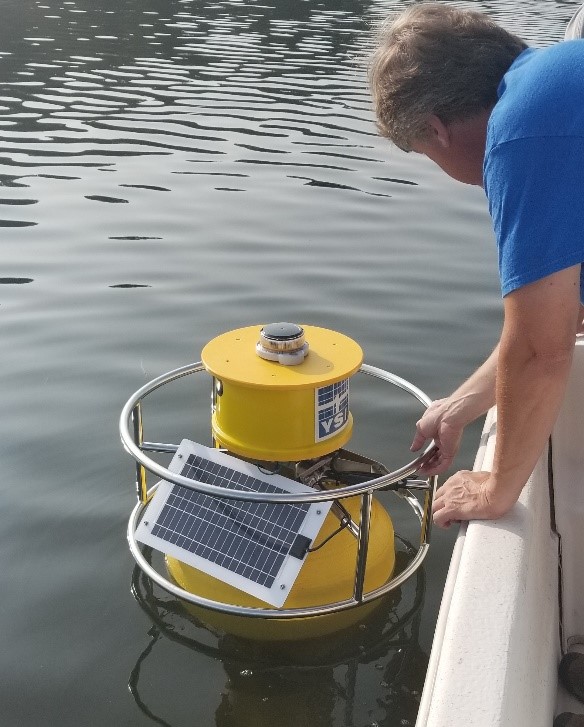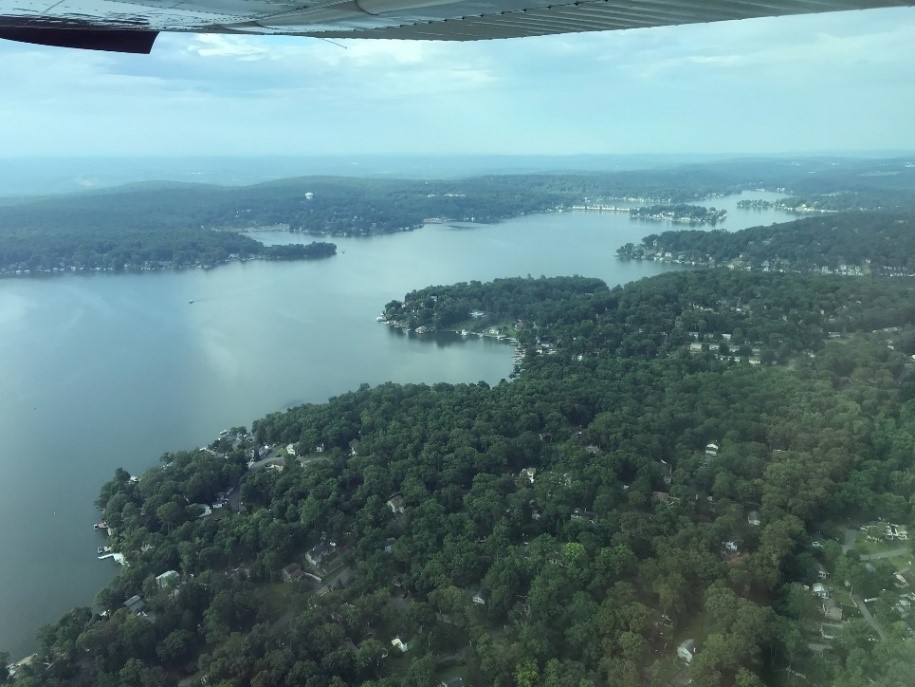|
FOR IMMEDIATE RELEASE |
Contact: Lawrence Hajna (609) 984-1795 |
|
HIGH-TECH BUOYS DEPLOYED AS PART OF MULTIFACETED RESPONSE TO LAKE HOPATCONG HARMFUL ALGAL BLOOM AS SWIMMING AND CONTACT ADVISORY REMAINS IN EFFECT (19/P057) TRENTON –The Department of Environmental Protection and U.S. Geological Survey this week deployed high-tech real-time monitoring buoys as part of a comprehensive response to the widespread Harmful Algal Bloom, or HAB, affecting northern New Jersey’s Lake Hopatcong. There is no scientifically sound treatment to eliminate HABs from water bodies, so advanced and continuous monitoring is the key element in protecting health and assessing when the lake is safe for recreation.
On Tuesday, the DEP deployed a real-time water monitoring buoy and the U.S. Geological Survey deployed a second buoy. These high-tech buoys will gather a wide range of water quality data, including phycocyanin pigments that are indicative of Harmful Algal Blooms, turbidity, salinity, dissolved oxygen, temperature, chlorophyll and pH. Click here for DEP real-time monitoring data for Lake Hopatcong. Click here for USGS real-time data. The buoys were deployed at two locations in the center of the lake, which is known locally as the main lake. This is the first time these types of buoys have been utilized in a lake in New Jersey. They will feed data constantly to DEP by way of cellular communication. The data they collect will supplement data the DEP has been collecting along shorelines, from boats, and from a state-of-the-art sensor used during weekly aerial surveillance. Monitoring will continue as long as necessary. Surface water samples will be collected every Tuesday and Thursday, with results posted to the DEP’s HAB website the following day. “We are committed to using all the tools at our disposal so that we can make strong, science-based decisions that will protect public health, help us understand when the bloom may dissipate, and keep the public informed,” said Division of Water Monitoring and Standards Director Bruce Friedman. “We truly appreciate the assistance of the U.S. Geological Survey. The data they collect collaboratively with the DEP helps us better understand the health of our ecosystems.” The DEP continues to advise that public beaches remain closed and that the public avoid swimming and water sports that may result in contact with water, such as jet-skiing, water-skiing, canoeing or kayaking. The DEP also advises the public that fish caught in the lake should not be consumed and that pets or livestock should not be permitted to drink or come in contact with the water. There is no recommended limitation on passive boating that does not involve bodily contact with the water. Higher levels of the bacteria causing the bloom are being found just beneath the surface, meaning areas of water may appear free of bloom even though harmful levels of the bacteria are present below the surface. Cyanobacteria levels in the lake remain above the state’s Health Advisory Guidance level. Exposure to cyanobacteria can cause a range of health effects, including rashes, allergy-like reactions, flu-like symptoms, gastroenteritis, respiratory irritation and eye irritation. More sensitive individuals can experience these health effects even at levels below the state’s guidance. Harmful Algal Blooms can also produce cyanotoxins at any time, which can result in more serious health concerns such as liver toxicity and neurological effects. Testing has detected cyanotoxins in the lake but not yet at levels above the state’s Health Advisory Guidance. The state’s largest lake, Lake Hopatcong is straddled by several municipalities in Sussex and Morris counties. It is the driving force in the regional tourism economy. The Lake Hopatcong bloom began as small blooms reported June 17 that rapidly grew to encompass much of the lake, leading to the DEP’s swimming, recreational use and bodily contact advisory, issued June 27. The reasons for the rapid spread are not known, but it may be due to stormwater runoff from heavy and persistent rainfall carrying nutrients into the lake followed by warm weather. These conditions may have caused naturally present cyanobacteria to grow rapidly. Primary sources of nutrients include septic systems, lawn fertilizers and animal wastes. The DEP is urging property owners to take the following steps:
The DEP is urging municipalities to take the following steps:
HABs, also known as blue-green algae, are usually a bright green, but can also appear as spilled paint, “pea soup,” or as having a thick coating or “mat” on the surface of the water. In recent years, the DEP and the New Jersey Department of Health have been enhancing Harmful Algal Bloom surveillance and response efforts across the state. In 2017, the DEP launched a campaign to educate the public about these blooms and provide resources on how to report them to the DEP. The “Avoid It and Report It” campaign advises the public to take the following steps when a suspicious bloom is observed:
### |
|
 “We share the frustrations of local residents, business owners and leaders about the widespread extent of this bloom and the impact it is having on the health of Lake Hopatcong and the local economy,” said Commissioner Catherine R. McCabe. “These buoys will help us to better understand what is causing the Harmful Algal Blooms and may help us predict conditions that may cause future blooms. To help prevent these occurrences, it is important that residents and municipalities do whatever they can to help reduce the flow of nutrients to the lake, including improved stormwater management, routine septic system cleaning and reduced use of fertilizers.”
“We share the frustrations of local residents, business owners and leaders about the widespread extent of this bloom and the impact it is having on the health of Lake Hopatcong and the local economy,” said Commissioner Catherine R. McCabe. “These buoys will help us to better understand what is causing the Harmful Algal Blooms and may help us predict conditions that may cause future blooms. To help prevent these occurrences, it is important that residents and municipalities do whatever they can to help reduce the flow of nutrients to the lake, including improved stormwater management, routine septic system cleaning and reduced use of fertilizers.”